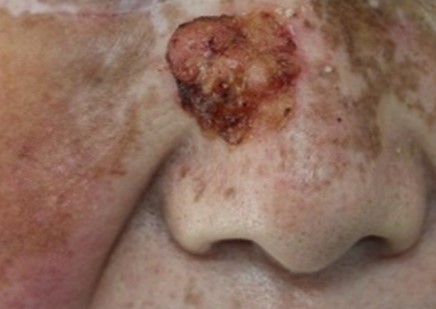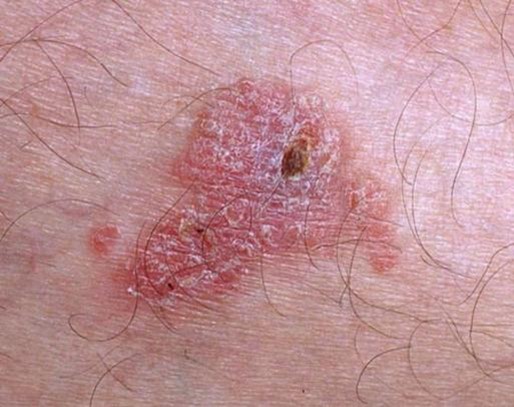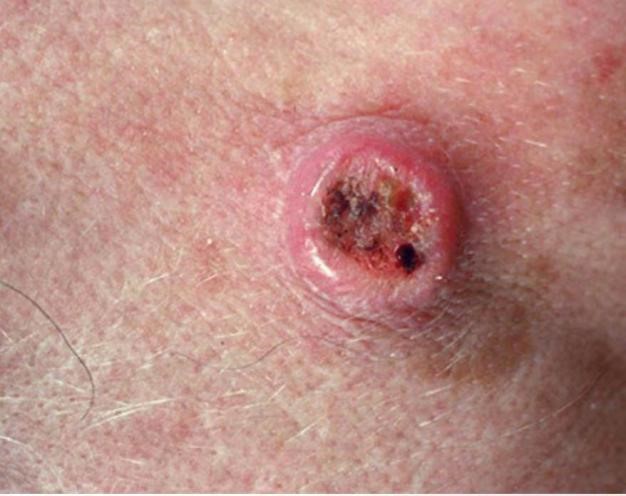Unfamiliar and dangerous facial pimple
Wang, 80, had a dark red, invasive patch on his face that was ignored at first, but grew bigger and bigger, slowly developing into a cauliflower shaped growth with sores and crusts. So came to the dermatology, after a biopsy diagnosis is: skin squamous cell carcinoma, Grandpa Wang a panic, a small red spot how to grow out of "cancer" it, today let us understand together to know about skin squamous cell carcinoma.

What is "skin squamous cell carcinoma"?
Squamous cell carcinoma of the skin is the second most common skin malignancy after basal cell carcinoma. It is most common in the elderly and can occur on any part of the skin surface. As ultraviolet radiation is the most important risk factor for squamous cell carcinoma, squamous cell carcinoma mostly occurs in exposed areas such as head, face and neck. In addition, immunosuppression, radiation exposure, burn scars, chronic ulcers and some genetic diseases are all risk factors for squamous cell carcinoma.
What does "skin squamous cell carcinoma" look like?
The clinical manifestations of squamous cell carcinoma are also different in different stages. Early squamous cell carcinoma in situ, also known as Bowen's disease, appears as red scaly patches or plaques, mostly at exposure sites, but also on the trunk and limbs. Squamous carcinoma in situ occurring in the anogenital mucosa may present as erosive erythema, also known as proliferative

Erythema.
Figure 2: Skin squamous cell carcinoma in situ
Invasive squamous cell carcinoma is a red keratinized plaque or nodule that may be ulcerated and grow aggressively.
There are also specific subtypes of squamous cell carcinoma worthy of our attention: the most common keratoacanthoma presents with rapidly growing papules and nodules within a few weeks, and develops into a crater-like rupture with a central horn plug.

Verrucous carcinoma usually occurs in plantar, vulva, oral mucosa and other places, and presents as verrucous proliferative plaques, nodules, ulcers, slow growth, often causing local destruction, but generally does not occur metastasis, the prognosis is relatively good.
What should I do if I suspect I have the above symptoms?
If you find that you have the above similar manifestations, you need to go to a regular hospital in time. Specialists will confirm the diagnosis through medical history, physical examination, skin imaging examination, skin biopsy and other relevant examinations, and conduct risk grade assessment to determine the appropriate treatment and formulate different follow-up plans to ensure the complete removal of the primary tumor, prevent metastasis and take into account the needs of aesthetics.
In short, for the elderly, especially the exposed parts of the skin, the above manifestations should be highly vigilant against squamous cell carcinoma, early detection, timely treatment, early diagnosis and treatment, is the key to our common face of squamous cell carcinoma of the skin!
Reference: Expert Consensus on the Diagnosis and Treatment of Cutaneous squamous Cell Carcinoma (2021)
Figures 2 and 3 are from UpToDate
Author: Han Yichen
Review: Geng Songmei
Editing by Du Xueshan
Author's institution: The Second Affiliated Hospital of Xi 'an Jiaotong University
(The views expressed are those of the author)

